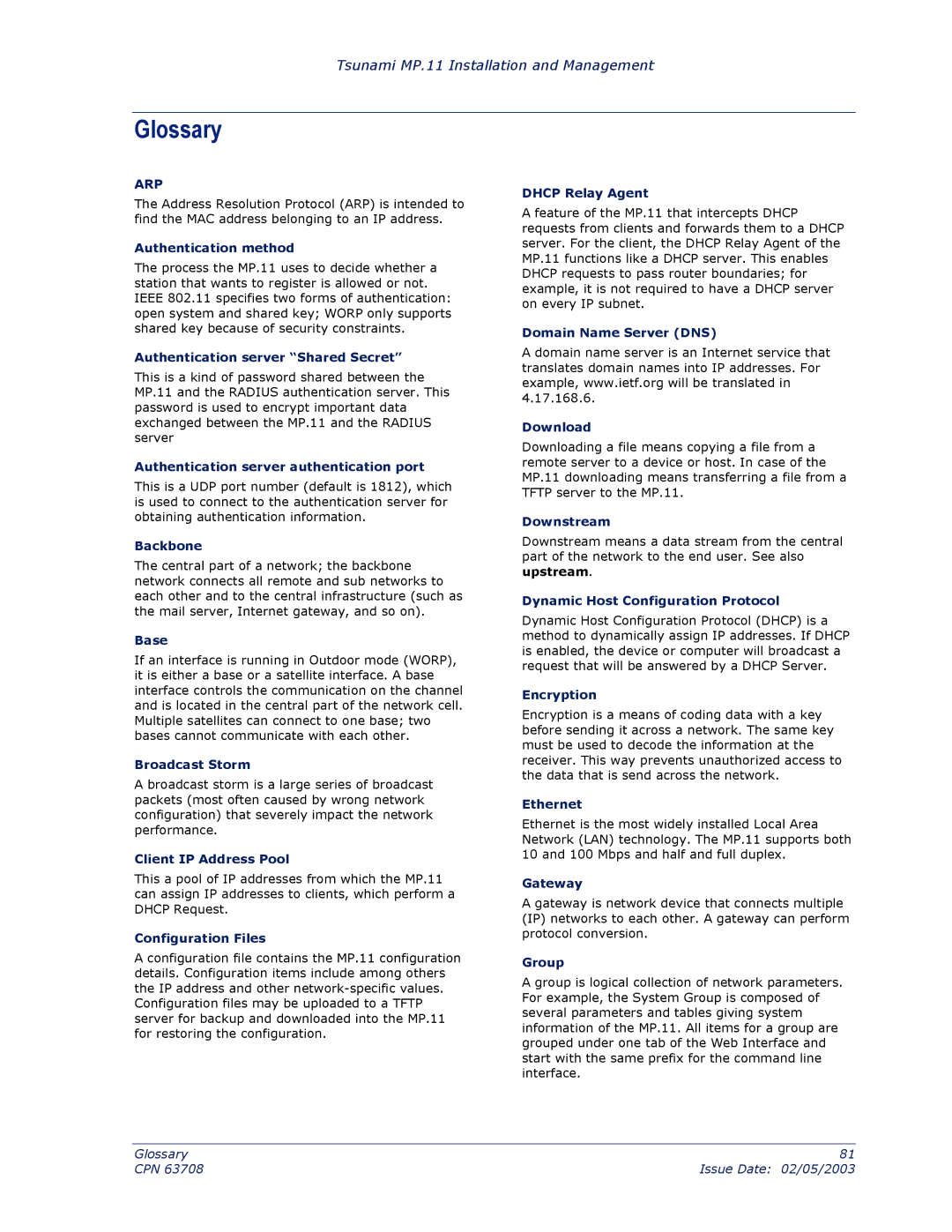
Tsunami MP.11 Installation and Management
Glossary
ARP
The Address Resolution Protocol (ARP) is intended to find the MAC address belonging to an IP address.
Authentication method
The process the MP.11 uses to decide whether a station that wants to register is allowed or not. IEEE 802.11 specifies two forms of authentication: open system and shared key; WORP only supports shared key because of security constraints.
Authentication server “Shared Secret”
This is a kind of password shared between the MP.11 and the RADIUS authentication server. This password is used to encrypt important data exchanged between the MP.11 and the RADIUS server
Authentication server authentication port
This is a UDP port number (default is 1812), which is used to connect to the authentication server for obtaining authentication information.
Backbone
The central part of a network; the backbone network connects all remote and sub networks to each other and to the central infrastructure (such as the mail server, Internet gateway, and so on).
Base
If an interface is running in Outdoor mode (WORP), it is either a base or a satellite interface. A base interface controls the communication on the channel and is located in the central part of the network cell. Multiple satellites can connect to one base; two bases cannot communicate with each other.
Broadcast Storm
A broadcast storm is a large series of broadcast packets (most often caused by wrong network configuration) that severely impact the network performance.
Client IP Address Pool
This a pool of IP addresses from which the MP.11 can assign IP addresses to clients, which perform a DHCP Request.
Configuration Files
A configuration file contains the MP.11 configuration details. Configuration items include among others the IP address and other
DHCP Relay Agent
A feature of the MP.11 that intercepts DHCP requests from clients and forwards them to a DHCP server. For the client, the DHCP Relay Agent of the MP.11 functions like a DHCP server. This enables DHCP requests to pass router boundaries; for example, it is not required to have a DHCP server on every IP subnet.
Domain Name Server (DNS)
A domain name server is an Internet service that translates domain names into IP addresses. For example, www.ietf.org will be translated in 4.17.168.6.
Download
Downloading a file means copying a file from a remote server to a device or host. In case of the MP.11 downloading means transferring a file from a TFTP server to the MP.11.
Downstream
Downstream means a data stream from the central part of the network to the end user. See also upstream.
Dynamic Host Configuration Protocol
Dynamic Host Configuration Protocol (DHCP) is a method to dynamically assign IP addresses. If DHCP is enabled, the device or computer will broadcast a request that will be answered by a DHCP Server.
Encryption
Encryption is a means of coding data with a key before sending it across a network. The same key must be used to decode the information at the receiver. This way prevents unauthorized access to the data that is send across the network.
Ethernet
Ethernet is the most widely installed Local Area Network (LAN) technology. The MP.11 supports both 10 and 100 Mbps and half and full duplex.
Gateway
A gateway is network device that connects multiple (IP) networks to each other. A gateway can perform protocol conversion.
Group
A group is logical collection of network parameters. For example, the System Group is composed of several parameters and tables giving system information of the MP.11. All items for a group are grouped under one tab of the Web Interface and start with the same prefix for the command line interface.
Glossary | 81 |
CPN 63708 | Issue Date: 02/05/2003 |
